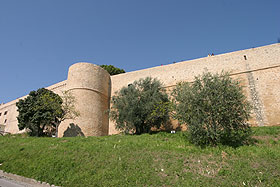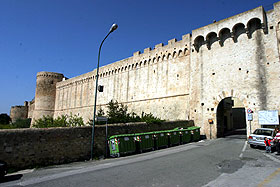Magliano in Toscana
Town Walls
 |
The western front. |
Magliano in Toscana is easy to reach following from the north the SS1 Aurelia, to the crossroad with the SP81, then SS323 that arrives directly into the town. From the south, leave the Aurelia at Albinia (SS74) and then continue until you reach the crossroad with the SS323 that will bring you to Magliano.
» More Photos of the Fortifications
» Photos from the Past
» Town Walls Plan
» Photos of the Hamlet
» Where is Magliano in Toscana located?
 The
strategic importance of Magliano, so close to
the sea and the inland of Mount Amiata
and Pitigliano, has never been doubted. Today the surrounding
walls of Magliano in Toscana are one of the most interesting
and complete medieval urban fortifications of Tuscany, not only
for their scenic effects but also for the excellent example of
military architecture that they
represent. On the hill where the village stand, there was once a castle,
mentioned for the first time in 1097 and included in all of the acts
of division of the territories of the Aldobrandeschi, counts of Santa
Fiora and lords of the area.
The
strategic importance of Magliano, so close to
the sea and the inland of Mount Amiata
and Pitigliano, has never been doubted. Today the surrounding
walls of Magliano in Toscana are one of the most interesting
and complete medieval urban fortifications of Tuscany, not only
for their scenic effects but also for the excellent example of
military architecture that they
represent. On the hill where the village stand, there was once a castle,
mentioned for the first time in 1097 and included in all of the acts
of division of the territories of the Aldobrandeschi, counts of Santa
Fiora and lords of the area.
In 1326 Magiano was occupied by the King of Naples and conceded to Carlo, Duke of Calabria and head of the imperial forces, to the Counts Pannocchieschi, but only after a year thanks to the intervention of Ludovico il Bavaro, it was given back to the Counts of Santa Fiora. Before abandoning the castle the Pannocchieschi burned it down.
 In 1358 the castle was perpetually
leased to the Republic of Siena that in turn
conceded it to the Lords at Spinello di Spinello Tolomei. The Sienese
immediately started restoring
the Keep, which no longer exists today, and in the twenty years
following, with the aid of specialized craftsmen, reinforced the surrounding
walls.
Additions and improvements were carried out during the early 15th century.
In 1358 the castle was perpetually
leased to the Republic of Siena that in turn
conceded it to the Lords at Spinello di Spinello Tolomei. The Sienese
immediately started restoring
the Keep, which no longer exists today, and in the twenty years
following, with the aid of specialized craftsmen, reinforced the surrounding
walls.
Additions and improvements were carried out during the early 15th century.
Today, three sides of the town walls are well preserved, interspersed with round towers and square towers, remnants of the ancient castle, perfectly merging with the preexisting Aldobrandeschi and late medieval Sienese additions. The wall walk, recently restored and that still can be used, is supported by suspended arches on upside down triangular shelves, a classic style of Sienese military architecture. The north side is joined with the houses and not easily visible. The Gate of San Giovanni on the south side, and that of San Martino on the north side are the two, still intact, original entrances to the enclosure. Next to the Gate of San Giovanni, you can still see the oldest part of the wall dominated by a square tower on which is the coat of arms of the Aldobrandeschi, Counts of the Holy Roman Empire, Imperial Vicars, is still visible.
 From here
the stone wall continues until it connects to the Sienese
walls on the west side, facing the sea, thicker than the others,
and interspersed with six round towers with, a considerable
novelty for the architecture of those times, with arrow slits.
The walls were originally taller and finished with a brick protrusion
with arches and crenellations. The present gate on this side, called
the Porta Nuova (New Gate) because it was constructed
later than the other two, was built in a different time. You can
see, in fact, the distinction between the truncated-pyramid body in
which it is integrated and the walls that surround it. The gate has an
opening in the form of an ogee arch bordered by elaborate brickwork and
is crowned by an large breteche.
From here
the stone wall continues until it connects to the Sienese
walls on the west side, facing the sea, thicker than the others,
and interspersed with six round towers with, a considerable
novelty for the architecture of those times, with arrow slits.
The walls were originally taller and finished with a brick protrusion
with arches and crenellations. The present gate on this side, called
the Porta Nuova (New Gate) because it was constructed
later than the other two, was built in a different time. You can
see, in fact, the distinction between the truncated-pyramid body in
which it is integrated and the walls that surround it. The gate has an
opening in the form of an ogee arch bordered by elaborate brickwork and
is crowned by an large breteche.
As already mentioned, on the north side one finds the Gate of San Martino, named for the nearby church that was the entrance to the ancient castle of Magliano, and is simpler than the New Gate. The machicolation is no longer there and there is a rounded arch opening in brick. The crenellation, Guelph, is probably a recreation. This tract of wall, even if modified in the Sienese period, is almost entirely that of the original built by the Aldobrandeschi.
| More Photos of the Walls |
| Town Walls Plan |
| Photos of the Hamlet |
| Back to Homepage |
| Back to Castles Index |